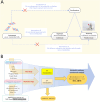Investigating the causal role of serum metabolites in substance use disorder risk: a study integrating Mendelian randomization and synthesis analysis
- PMID: 40828213
- PMCID: PMC12364769
- DOI: 10.1007/s44192-025-00275-6
Investigating the causal role of serum metabolites in substance use disorder risk: a study integrating Mendelian randomization and synthesis analysis
Abstract
Objective: This study aimed to explore how serum metabolites affect the risk of substance use disorders (SUD).
Methods: In the initial stage, Mendelian randomization was applied to assess the relationship between 1,400 serum metabolites and SUD. Inverse variance weighting, the Wald ratio odds ratio, and 95% confidence intervals were primarily used to evaluate causal relationships, and the false discovery rate was used for multiple comparison corrections. Sensitivity analysis was conducted via Cochran's Q test and MR-PRESSO. The MR-Steiger test was used to examine reverse causality. In the validation stage, we sought additional GWAS data on SUD to verify the initial results. Furthermore, the pathway enrichment analysis was conducted for known metabolites that exhibited causal relationships with SUD in both phases.
Results: In the initial phase, we analysis suggests that these 77 metabolites may have potential causal associations with SUD, including 14 metabolite ratios and 63 metabolites (49 known and 14 unknown). In the validation phase, for 57 metabolites (38 known, 6 unknown, 13 ratios), confirmed associations may indicate causal effects on SUD incidence. The synthesis analysis results indicated that the overall effect of the combined metabolites was consistent with the primary analysis with two identified as risk factors and four as protective factors for SUD. Specifically, Erythronate levels, 1-(1-enyl-stearoyl)-2-oleoyl-GPE (P-18:0/18:1) levels, aspartate to citrulline ratios, and cis-4-decenoate (10:1n6) levels were negatively correlated with SUD, whereas gamma-glutamyl-alpha-lysine and ethyl alpha-glucopyranoside levels were positively correlated with disease incidence. The metabolites linked to the risk of SUD in both phases were primarily enriched in several metabolic pathways, including pantothenate and CoA biosynthesis; pyrimidine metabolism; biosynthesis of valine, leucine, and isoleucine; taurine and hypotaurine metabolism; histidine metabolism; and glycerolipid metabolism.
Conclusion: Circulating metabolites may have a causal relationship with the risk of SUD. "Specific metabolites may be potential biomarkers for SUD, contributing to risk prediction and the development of personalized treatment strategies".
Keywords: Causal effects; Lipid metabolism; Mendelian randomization; Metabolites; Substance use disorder.
© 2025. The Author(s).
Conflict of interest statement
Declarations. Ethical approval and consent to participate: This study involves secondary analysis of aggregated-level data from published studies or publicly available databases. All original studies were approved by the respective institutional review boards at the time of publication and comply with the principles of the Declaration of Helsinki. This secondary analysis study does not involve direct contact with or collection of new human subject data or biological samples. Therefore, in accordance with the regulations of the Ethics Review Committee of the 910th Hospital of the Chinese People’s Liberation Army Joint Logistics Support Force, no additional ethical approval is required. The conduct of this study strictly adhered to all relevant data usage agreements and ethical guidelines. This study uses publicly available, de-identified summary statistics that do not contain any personally identifiable information. Therefore, it is not necessary to obtain new informed consent specifically for this study. The informed consent process for participants in the original studies was completed during the data generation phase (i.e., in the original GWAS and metabolite studies), which were approved by the respective ethics committees and obtained written informed consent from all participants to use their data for future genetic and health-related research. Consent for publication: All data used in this study are publicly available summary statistics from published literature or public databases. The results reported in this study are based solely on summary-level statistical analyses and do not disclose any information that could identify individuals. Therefore, no additional consent is required for the publication of the results of this study. Competing interests: The authors declare no competing interests.
Figures





Similar articles
-
[Multi-omics Mendelian randomization study on the causality between non-ionizing radiation and facial aging].Zhonghua Shao Shang Yu Chuang Mian Xiu Fu Za Zhi. 2025 Jun 20;41(6):594-603. doi: 10.3760/cma.j.cn501225-20240830-00320. Zhonghua Shao Shang Yu Chuang Mian Xiu Fu Za Zhi. 2025. PMID: 40588408 Free PMC article. Chinese.
-
Prescription of Controlled Substances: Benefits and Risks.2025 Jul 6. In: StatPearls [Internet]. Treasure Island (FL): StatPearls Publishing; 2025 Jan–. 2025 Jul 6. In: StatPearls [Internet]. Treasure Island (FL): StatPearls Publishing; 2025 Jan–. PMID: 30726003 Free Books & Documents.
-
Psychological therapies for post-traumatic stress disorder and comorbid substance use disorder.Cochrane Database Syst Rev. 2016 Apr 4;4(4):CD010204. doi: 10.1002/14651858.CD010204.pub2. Cochrane Database Syst Rev. 2016. PMID: 27040448 Free PMC article.
-
Inflammatory cytokines mediate the gut microbiota-EGPA subtype link: a Mendelian randomization study.Clin Rheumatol. 2025 Jul;44(7):3061-3071. doi: 10.1007/s10067-025-07526-5. Epub 2025 Jun 12. Clin Rheumatol. 2025. PMID: 40500572
-
Gender differences in the context of interventions for improving health literacy in migrants: a qualitative evidence synthesis.Cochrane Database Syst Rev. 2024 Dec 12;12(12):CD013302. doi: 10.1002/14651858.CD013302.pub2. Cochrane Database Syst Rev. 2024. PMID: 39665382
References
-
- Airagnes G, et al. Nicotine dependence and incident psychiatric disorders: prospective evidence from US National study. Mol Psychiatry. 2025;30(3):1080–8. - PubMed
Publication types
LinkOut - more resources
Full Text Sources

